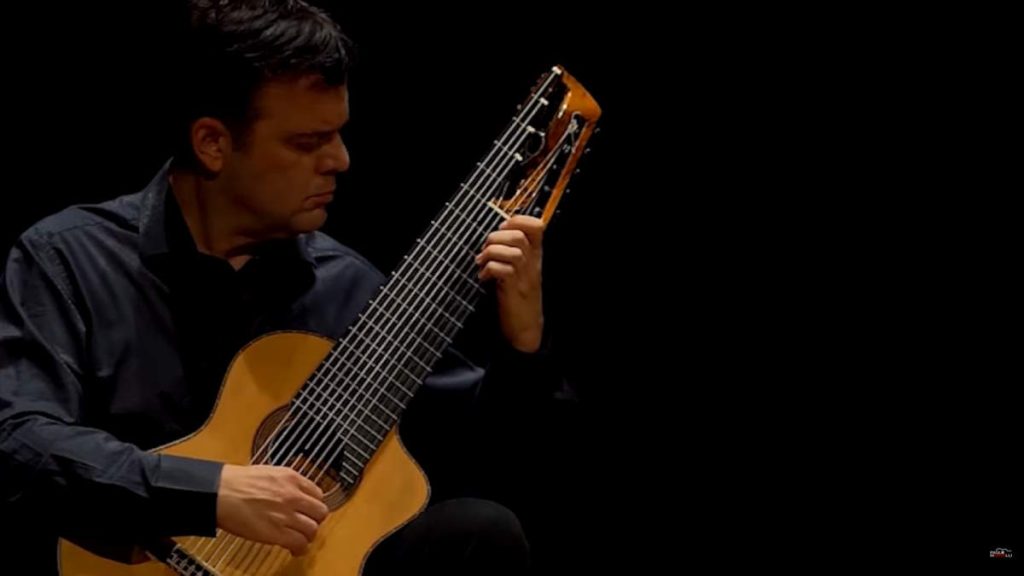Brazilian classical guitarist Paulo Martelli plays Johann Sebastian Bach’s Cello Suite No. 2 BWV 1008. Martelli’s 11-string alto guitar was made by Samuel Carvalho, the Brazilian master guitar builder in 2004.
Program (with start times in the video):
- 0:00 Prelude
- 4:08 Allemande
- 7:27 Courante
- 9:35 Sarabande
- 14:08 Minuet I / II
- 17:00 Gigue
Johann Sebastian Bach’s Cello Suite No. 2 BWV 1008
Johann Sebastian Bach’s Cello Suite No. 2 in D minor, BWV 1008, is one of the most revered works in the classical cello repertoire. Composed during Bach’s time in Cöthen, Germany, between 1717 and 1723, this suite is part of a collection of six suites for unaccompanied cello. These suites, each consisting of a prelude followed by a series of dance movements, represent a pinnacle of baroque solo string writing and are celebrated for their rich musicality and technical demands.
The Cello Suite No. 2, in particular, stands out for its depth of emotion and complexity. Set in the key of D minor, it possesses a darker, more introspective quality compared to some of the other suites. This key choice imparts a somber, contemplative character to the suite, making it particularly expressive and profound.
The suite follows the typical structure of a Baroque suite, consisting of six movements:
- Prelude: This opening movement is notable for its flowing, introspective melody and its use of a recurring motif. The prelude sets the mood for the entire suite, with its meditative quality and intricate voicing.
- Allemande: A more measured and solemn dance form, the Allemande in this suite is characterized by its careful counterpoint and lyrical lines. It’s a movement that requires both technical precision and expressive nuance.
- Courante: This is a lively, more upbeat dance movement. In the Courante, Bach’s skill in rhythm and melody comes to the fore, offering a contrast to the suite’s overall somberness.
- Sarabande: The Sarabande is the emotional heart of the suite, slow and deeply expressive. Its sustained notes and open harmonies require a profound sense of phrasing from the cellist, highlighting the instrument’s singing qualities.
- Minuets I and II: These two minuets are played as a pair, with the first one in D minor and the second in D major, providing a brief but poignant contrast. The return to the first minuet after the second gives a sense of rounded completeness to this section of the suite.
- Gigue: The final movement, the Gigue, brings the suite to a close with energy and vigor. It’s a fast-paced dance that contrasts with the more reflective movements earlier in the suite.
Each of these movements is not just a display of technical prowess but also an exploration of the emotional range of the cello. Bach’s Cello Suite No. 2 requires the performer to navigate complex polyphonic lines (multiple melodies played simultaneously), a challenging task on an instrument primarily designed for single-line melody. The suite’s unaccompanied nature demands that the cellist brings out the harmonic structure and implied counterpoint solely through their interpretation.
Bach’s Cello Suites, including the second suite, were not widely known or performed until the early 20th century when cellist Pablo Casals brought them to the forefront of the classical music world. Today, they are considered essential works for cellists, offering both technical challenges and profound musical depth. The Cello Suite No. 2 in D minor, with its introspective beauty and emotional depth, remains a beloved piece in the solo cello literature, revered by both performers and audiences alike.
Paulo Martelli
Paulo Martelli is a Brazilian classical guitarist. He received musical training in New York where he studied at The Juilliard School and The Manhattan School of Music. He has garnered awards and honors in prestigious national and international competitions and has concertized at halls throughout the United States, Canada, and Brazil. He is noted for being an advocate and practitioner of the eleven-string alto guitar, an unusual non-standard instrument that is well suited to the performance of music originally intended for the lute.

Sources
- The Six suites for unaccompanied cello by Johann Sebastian Bach on Wikipedia
- Paulo Martelli on Wikipedia
